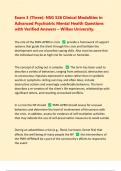Exam 3 (Three): NSG 526 Clinical Modalities in
Advanced Psychiatric Mental Health Questions
with Verified Answers – Wilkes University.
The role of the PMH-APRN in crisis provide a framework of support
systems that guide the client through the crisis and facilitate the
development and use of positive coping skills. Also must be aware that
the individual may be at high risk for suicide or homicide.
The concept of acting out is complex. The term has been used to
describe a variety of behaviors, ranging from antisocial, destructive acts
to unconscious impulses expressed in action rather than in symbolic
words or symptoms. Acting out may, and often does, include
destructive actions and seemingly undefinable behaviors. The term
describes a re-creation of the client's life experiences, relationships with
significant others, and resulting unresolved conflicts.
In a crisis the NP should PMH-APRN should assess for unusual
behaviors and determine the level of involvement of the person with
the crisis. In addition, assess for evidence of self-mutilation activities
that may indicate the use of self-preservation measures to avoid suicide
During an adventitious crisis (e.g., flood, hurricane, forest fire) that
affects the well-being of many people the NP the interventions of
the PMH-APRNwill be a part of the community's efforts to respond to
the event.
,when a personal crisis occurs the person in crisis may have only the
PMH-APRN to respond to his or her needs. After the assessment, the
PMH-APRN must decide whether to provide the care needed or to refer
the person to a psychiatrist.
A situational crisis occurs whenever a specific stressful event
threatens a person's biopsychosocial integrity and results in some
degree of psychological disequilibrium. The event can be an internal
one, such as a disease process or any number of external threats. A
move to another city, a job promotion, or graduation from high school
can initiate a crisis even though they are positive events.
If a person enters a new situation without adequate coping skills a
crisis may develop, resulting in dissonance (inconsistency between
attitude and behavior).
Role of APRN in Crisis he role of the PMH-APRN is to provide a
framework of support systems that guide the
client through the crisis and facilitate the development and use of
positive coping skills.
Assess risk of homicide/suicide/self-injury
Assess coping skills
,Assess perception of problem and support mechanisms
Assess biologic items - sleep, eating, hygiene, etc
Assess psychological - emotions and coping
Asses social - individual, family, community. Social support
Disaster A disaster is a sudden ecological or man-made
phenomenon that is of sufficient
magnitude to require external help to address the psychosocial needs
as well as
the physical needs of the victims
MCI triage category: Expectant Injuries are extensive and chances
of survival are unlikely
even with definitive care. Separate and provide comfort
Unresponsive patients with penetrating head wounds, high
spinal cord injuries, wounds involving multiple anatomical sites
and organs, 2nd/3rd degree burns in excess of 60% of body surface
area, seizures or vomiting within 24hr after radiation
, exposure, profound shock with multiple injuries, agonal
respirations; no pulse, no BP, pupils fixed and dilated
MCI Category: Immediate Injuries are life-threatening but
survivable with minimal
intervention. Individuals in this group can progress rapidly to expectant
if treatment is delayed.
Sucking chest wound, airway obstruction secondary to
mechanical cause, shock, hemothorax, tension pneumothorax,
asphyxia, unstable chest and abdominal wounds, incomplete
amputations, open fractures of long bones, and 2nd/3rd degree
burns of 15%-40% total body surface area
MCI Category: Delayed Injuries are significant and require medical
care but can wait
hours without threat to life or limb. Individuals in this group receive
treatment only after immediate casualties are treated.
Stable abdominal wounds without evidence of significant
hemorrhage; soft tissue injuries; maxillofacial wounds without
airway compromise; vascular injuries with adequate collateral
circulation; genitourinary tract disruption; fractures requiring




